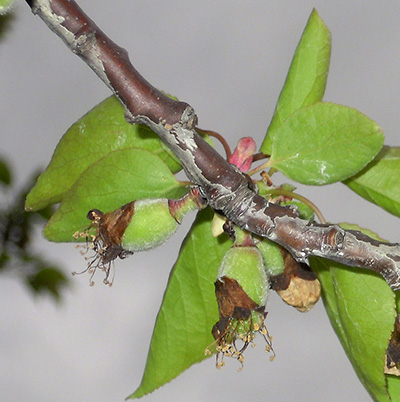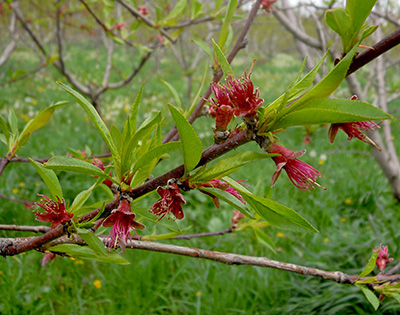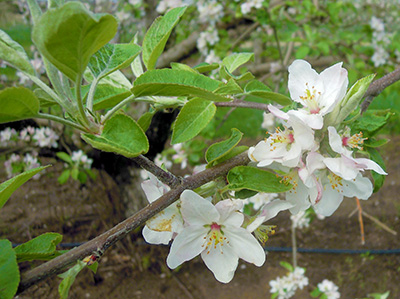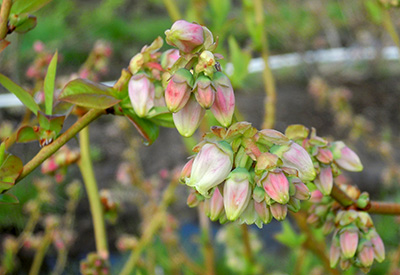Southwest Michigan fruit regional report – May 3, 2016
A cool, wet week during bloom has growers applying protectant sprays between rains.

Weather
Last week started warm and wet on Monday, April 25. High temperatures were in the low 80s for early week and fell into the low 50s from mid-week to the weekend. Low temperatures were in the low 40s. There were scattered rains last week and soils are wet. The weekend was wet and thunderstorms moved through Sunday night. Rainfall last week was about 1.2 to 1.5 inches of rain. There were several infection periods for fruit diseases during the week. Low temperatures on Tuesday, May 3, dropped to near freezing in low areas and may have caused some damage to unprotected crops. Rainfall totals for April averaged 3.5 inches for the region. Plants have leafed out relatively rapidly despite the cool temperatures due to the warm, moist soils and warmer night temperatures.
High temperatures for the upcoming week are forecast to start in the 60s. The passage of a cold front Wednesday, May 4, will bring rain and highs in the 50s mid-week. Temperatures will rebound into the 70s for the weekend. Low temperatures will be around 40.
Temperatures dropped near freezing Tuesday morning, May 3; with the exception of strawberries, no fruit crops should have been damaged. No freezes are in the forecast and there is only a slight chance of damaging freezes in May. Growing degree-day (GDD) heat accumulations last week were low. We are still about a week ahead of normal for heat accumulation. Continued cooler weather this week will slow down plant development.
Southwest Michigan GDD summary from Jan. 1 through May 1, 2016 |
|||
|---|---|---|---|
|
Station |
GDD 42 F |
GDD 45 F |
GDD 50 F |
|
Benton Harbor (SWMRC) |
449 |
346 |
214 |
|
Lawton (Lawton) |
450 |
346 |
211 |
|
Fennville (TNRC) |
348 |
261 |
154 |
|
Average for the region |
407 |
309 |
187 |
|
Accumulation last week |
47 |
31 |
16 |
Tree fruit
Stone fruit bloom is ending. Apple bloom is underway. Rains last week were probably too cool for brown rot. Insect activity was low last week because of the cool temperatures. Green fruitworm moths have been flying for three weeks. Larvae from this insect are the first to target fruit after petal fall. Oriental fruit moth are flying. Michigan State University Extension suggests growers scout for Eastern tent caterpillar webs and remove them. There were several extended wetting periods during the week which were heavy infection periods for foliar diseases. The most significant wetting period began Saturday, April 30. This wetting period was a moderate infection period for bacterial spot, cherry leaf spot and a significant infection period for apple scab.
Apricots are in the shuck and early shuck split.

Apricots are at shuck split.
Peaches are in the shuck. Biofix first flight of oriental fruit moth was set Monday, April 25, based on trap catches at the Trevor Nichols Station trap line. Biofix is used for timing sprays against the larvae which can cause flagging damage on branch tips of young peach trees. Pheromones for mating disruption should be out. The rains favor bacterial spot infection of young leaves.

Bloom has ended and these peaches are in the shuck.
Sweet cherries are in the shuck. Sweet cherries are susceptible to brown rot at all times, so growers need to maintain protection on the fruit as it emerges from the shuck. Cherry leaf spot infects cherry leaves through the stomates and, once unrolled, the leaves are always susceptible to infection.
Tart cherries are at petal fall. Leaves emerged rapidly last week and growers have been applying protectant fungicides to protect the leaves. The long wetting period beginning April 30 was an infection period for cherry leaf spot in many locations. Many southwestern tart cherry orchards lost their leaves early last year because of the wet June and these weakened trees are blooming later than trees that held onto their leaves most of the season.
Japanese plums are in shuck to early shuck split.
European plums are at petal fall to in the shuck. Plums need to be protected against black knot from first bloom until second cover.
Apple orchards are near full bloom and early petal fall in Berrien County. There is a wide variation in apple bloom across the region. In Van Buren County, most varieties are at king bloom to full bloom. Rain on Monday, April 25, was a fire blight infection period in some orchards in Berrien County. Rain and hail from the April 25 storms had growers with open bloom putting on antibiotics to prevent or reduce fire blight infection. Now is the time to apply Apogee to reduce growth and suppress any fire blight infection. Bloom will develop slowly this week, but warm conditions will return by the weekend and a fire blight infection is certainly possible with warm, wet conditions.
Apple scab ascospores numbers are declining from peak numbers in the last two weeks. Several scab infection periods were recorded in the region. No leaf scab symptoms have been found. Symptoms from more recent infection periods should become visible after Mother’s Day, May 8. Spotted tentiform leafminer have been flying for about two weeks. Redbanded leafroller trap catch is high.

McIntosh apples at full bloom.
Pear bloom is ending. Most of the petals have fallen. Pear psylla adults are flying. Pears also need to be protected against pear scab and fire blight.
Small fruit
Juice grape buds are at 1-3 inch shoot growth. In warmer areas, several leaves have folded back, exposing the flower clusters. Hybrid wine grapes vary, but the most advanced have leaves unfolding. Vinifera grapes are at bud burst. As the buds open and shoot growth begins, shoot tissue becomes vulnerable to infection from powdery mildew and phomopsis. Fungicides to control these diseases are usually applied as flower clusters become visible. Last week’s wet, rainy conditions were good for phomopsis infection.
Grape flea beetles and climbing cutworms will be feeding in vineyards where they are present. Where problems with these pests have appeared in the past, scout weekly from now until 3 inches of growth. Grape berry moth flight has begun, but first generation egglaying is about a month away.
Blueberries are at pink bud and bloom has begun in many fields. The bud set looks very heavy in some areas. Leaves are unfolding and shoots are growing rapidly. Water is standing in many fields. Growers applied sprays to reduce mummy berry shoot blight. During bloom, the site of control for preventing mummy berry infection shifts the flowers. Bees and other pollinators carry mummy berry spores from shoot strikes to open bloom. Good pollination conditions are good mummy berry infection conditions if there are shoot strikes in the area. The flowers are susceptible to infection as they open and susceptibility declines as the flowers age. Sprays are timed for early bloom and mid-bloom.
At petal fall, anthracnose becomes a concern and the preferred fungicide changes to include action against anthracnose, mummy berry and phomopsis. Growers should avoid spraying in the middle of the day when bees are foraging the bloom. Cherry fruitworm and cranberry fruit worm should emerge soon with warmer weather. See “Time to prepare for fruitworm management in blueberries” for more information.

First bloom in Duke blueberries.
Strawberry leaves are still emerging from the crown as well as the flower trusses. Once the flower buds emerge, they can be killed by cold temperatures in the low to mid-20s. At this time, leaf diseases are the primary concern in strawberries. Common strawberry leaf spot is the chief concern. If the weather is wetter than predicted, annular leaf spot could be a problem. Growers have put out straw and some have ran sprinklers to prevent frost-damage to the exposed flower buds.
Bramble growth continues. Leaves are unfolding in raspberries and the flower clusters can be seen. The main concern is orange rust in blackberries and black raspberries. Effective controls can be found in the 2016 Michigan Fruit Management Guide (E0154).
Cranberries are just starting to green up and bud swell can be seen in the warmer fields.
Upcoming meetings
Our next Monday fruit IPM meeting in southwest Michigan is May 9 at Fruit Acres Farms, 2559 Friday Road on the northeast corner of Friday and Carmody Roads, south of Coloma, at 5 p.m. Two Michigan pesticide applicator recertification credits will be given for these meetings.
Related articles
- Minimizing pesticide exposure to bees in fruit crops
- Management of bacterial spot on peaches and nectarines
- Chlorothalonil use for pre-shuck split cherry leaf spot control
- Fungicide considerations for cherry leaf spot control at first cover
- Controlling cherry leaf spot in orchards with early infections
- How to use Enviro-weather’s apple scab tool
- SDHI fungicides for apple scab management
- Update on resistance to strobilurin fungicides in the apple scab fungus in Michigan
- How to use the Enviroweather Fire Blight Model
- A primer for Streptomycin, Kasumin, and Oxytetracycline use for fire blight management
- Apogee for fire blight (shoot blight) management
- Protect new grape shoots from early-season fungal diseases
- Mummy berry springs into action: How to manage this disease
- Mummy berry management in blueberries during bloom
- Invest in pollination for success with highbush blueberries
- Time to prepare for fruitworm management in blueberries.
- Watch out for angular leaf spot in strawberries
- Monitor for orange rust in brambles



 Print
Print Email
Email
